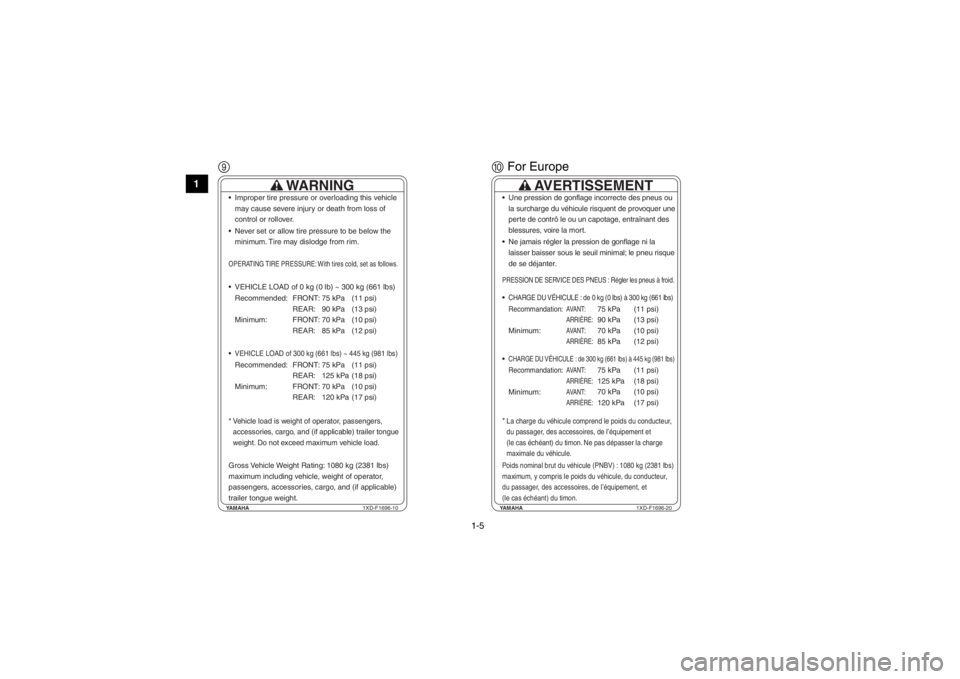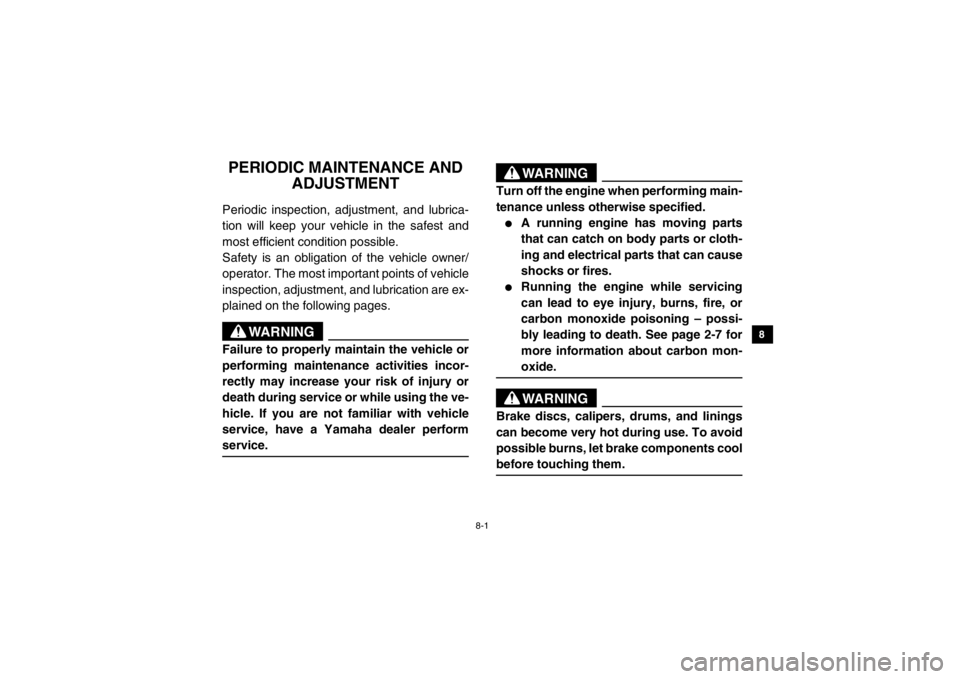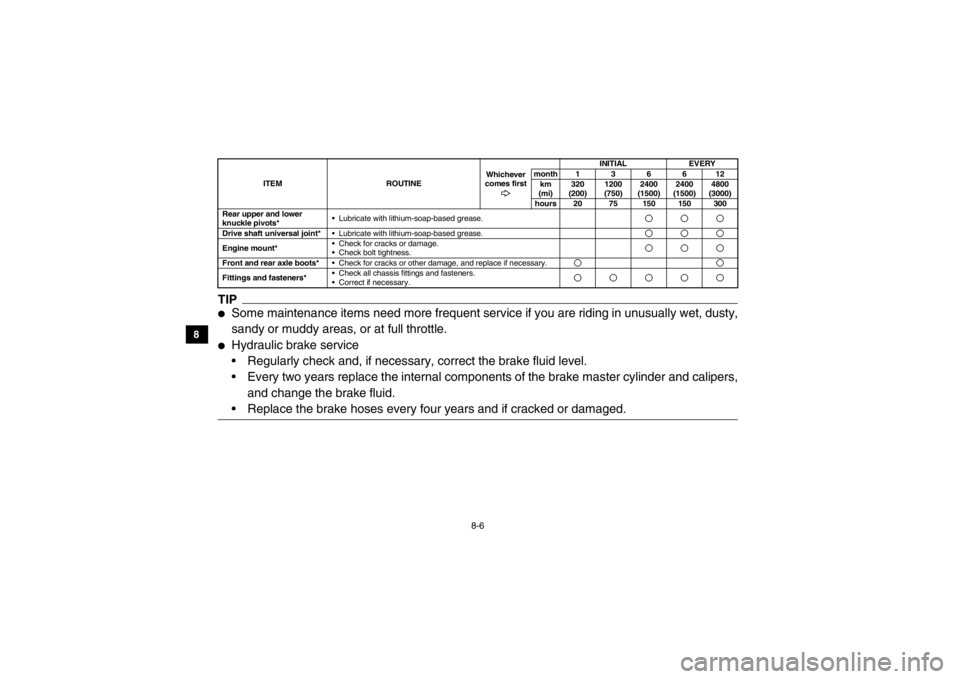Page 14 of 180

1-5
1
2
3
4
5
6
7
8
9
10
11
12
13
14
90 For EuropeYAMAHA 1XD-F1696-10
WARNING
Improper tire pressure or overloading this vehicle
may cause severe injury or death from loss of
control or rollover.
Never set or allow tire pressure to be below the minimum. Tire may dislodge from rim.
VEHICLE LOAD of 0 kg (0 lb) ~ 300 kg (661 lbs) Recommended: FRONT: REAR:
Minimum: FRONT: REAR:75 kPa
90 kPa
70 kPa
85 kPa
VEHICLE LOAD of 300 kg (661 lbs) ~ 445 kg (981 lbs)Recommended: FRONT: REAR:
Minimum: FRONT: REAR:75 kPa
125 kPa
70 kPa
120 kPa (11 psi)
(13 psi)
(10 psi)
(12 psi)
(11 psi)
(18 psi)
(10 psi)
(17 psi)
*Vehicle load is weight of operator, passengers,
accessories, cargo, and (if applicable) trailer tongue
weight. Do not exceed maximum vehicle load.Gross Vehicle Weight Rating: 1080 kg (2381 lbs)
maximum including vehicle, weight of operator,
passengers, accessories, cargo, and (if applicable)
trailer tongue weight.OPERATING TIRE PRESSURE: With tires cold, set as follows.
YAMAHA 1XD-F1696-20
AVERTISSEMENT
Une pression de gonflage incorrecte des pneus ou
la surcharge du véhicule risquent de provoquer une
perte de contrô le ou un capotage, entraînant des
blessures, voire la mort.
Ne jamais régler la pression de gonflage ni la laisser baisser sous le seuil minimal; le pneu risque
de se déjanter.
CHARGE DU VÉHICULE : de 0 kg (0 lbs) à 300 kg (661 lbs)Recommandation:
AVANT:
ARRIÈRE:
Minimum:
AVANT:
ARRIÈRE:
CHARGE DU VÉHICULE : de 300 kg (661 lbs) à 445 kg (981 lbs)Recommandation:
AVANT:
ARRIÈRE:
Minimum:
AVANT:
ARRIÈRE:
(11 psi)
(13 psi)
(10 psi)
(12 psi)
(11 psi)
(18 psi)
(10 psi)
(17 psi)
75 kPa
90 kPa
70 kPa
85 kPa
75 kPa
125 kPa
70 kPa
120 kPa
*
La charge du véhicule comprend le poids du conducteur,
du passager, des accessoires, de l’équipement et
(le cas échéant) du timon. Ne pas dépasser la charge
maximale du véhicule.Poids nominal brut du véhicule (PNBV) : 1080 kg (2381 lbs)
maximum, y compris le poids du véhicule, du conducteur,
du passager, des accessoires, de l’équipement, et
(le cas échéant) du timon.PRESSION DE SERVICE DES PNEUS : Régler les pneus à froid.
1XP7B_EE.book Page 5 Tuesday, February 4, 2014 3:40 PM
Page 59 of 180
4-27
1
2
34
5
6
7
8
9
10
11
12
13
14
5UG1B001 The front and rear shock absorber
assemblies
WARNING
These shock absorber assemblies contain
highly pressurized nitrogen gas. Read and
understand the following information be-
fore handling the shock absorber assem-
blies.●
Do not tamper with or attempt to open
the cylinder assemblies.
●
Do not subject the shock absorber as-
semblies to an open flame or other
high heat source. This may cause the
unit to explode due to excessive gas
pressure.
●
Do not deform or damage the cylin-
ders in any way. Cylinder damage will
result in poor damping performance.
●
Do not dispose of a damaged or worn
out shock absorber assembly your-
self. Take the shock absorber assem-
bly to a Yamaha dealer for any
service.
1XP7B_EE.book Page 27 Tuesday, February 4, 2014 3:40 PM
Page 70 of 180

5-8
5
6
7
8
9
10
11
12
13
14
A crash can damage the restraint systems in
your vehicle. A damaged restraint system
may not properly protect the person using it,
resulting in serious injury or death in a crash.
To help make sure your restraint systems are
working properly after a crash, have them in-
spected and any necessary replacements
made as soon as possible.Passenger handholdCheck that the handhold bar and its supports
are in good condition. Confirm that the locking
pins are securely fastened, and then push
and pull on the handhold to make sure that it
is not loose.EVU01230SteeringPark on level ground. Turn the steering wheel
right and left. Check for excessive free play,
abnormal noises, or a rough feeling. Have a
Yamaha dealer repair as necessary for proper operation.
EVU00470Fittings and fastenersAlways check the tightness of chassis fittings
and fasteners before a ride. Take the vehicle
to a Yamaha dealer or refer to the Service
Manual for correct tightening torque.Instruments, lights and switchesCheck that all instruments, lights and switches
are working properly. Correct if necessary.Control cablesWhen riding in cold weather, always make
sure all control cables work smoothly before
you begin riding. WARNING! Control cables
can freeze in cold weather and you could
be unable to control the vehicle.EVU00500TiresCheck tire pressure regularly to make sure it
is at the recommended specifications. Also
check for wear and damage.
1XP7B_EE.book Page 8 Tuesday, February 4, 2014 3:40 PM
Page 111 of 180

8-1
1
2
3
4
5
6
78
9
10
11
12
13
14
EVU006501-PERIODIC MAINTENANCE AND ADJUSTMENTPeriodic inspection, adjustment, and lubrica-
tion will keep your vehicle in the safest and
most efficient condition possible.
Safety is an obligation of the vehicle owner/
operator. The most important points of vehicle
inspection, adjustment, and lubrication are ex-
plained on the following pages.
WARNING
Failure to properly maintain the vehicle or
performing maintenance activities incor-
rectly may increase your risk of injury or
death during service or while using the ve-
hicle. If you are not familiar with vehicle
service, have a Yamaha dealer perform
service.
WARNING
Turn off the engine when performing main-
tenance unless otherwise specified.●
A running engine has moving parts
that can catch on body parts or cloth-
ing and electrical parts that can cause
shocks or fires.
●
Running the engine while servicing
can lead to eye injury, burns, fire, or
carbon monoxide poisoning – possi-
bly leading to death. See page 2-7 for
more information about carbon mon-
oxide.WARNING
Brake discs, calipers, drums, and linings
can become very hot during use. To avoid
possible burns, let brake components cool
before touching them.
1XP7B_EE.book Page 1 Tuesday, February 4, 2014 3:40 PM
Page 112 of 180
8-2
8
9
10
11
12
13
14
EVU00660Owner’s manual and tool kitYou are recommended to put this owner’s
manual in the vinyl bag and always carry it in
the glove compartment as shown. Put the
owner’s tool kit and tire pressure gauges un-
der the right passenger seat.1. Owner’s manual 1. Owner’s tool kit 2. Tire pressure gauge (
× 2)
The service information included in this man-
ual is intended to provide you, the owner, with
the necessary information for completing your
own preventive maintenance and minor re-
pairs.
The tools provided in the owner’s tool kit are
sufficient for this purpose, except that a torque
wrench is also necessary to properly tighten
nuts and bolts.
1
1
2
1XP7B_EE.book Page 2 Tuesday, February 4, 2014 3:40 PM
Page 113 of 180
8-3
1
2
3
4
5
6
78
9
10
11
12
13
14
If you do not have a torque wrench available
during a service operation requiring one, take
your vehicle to a Yamaha dealer to check the
torque settings and adjust them as necessary.1XP7B_EE.book Page 3 Tuesday, February 4, 2014 3:40 PM
Page 116 of 180

8-6
8
9
10
11
12
13
14
TIP●
Some maintenance items need more frequent service if you are riding in unusually wet, dusty,
sandy or muddy areas, or at full throttle.
●
Hydraulic brake service
Regularly check and, if necessary, correct the brake fluid level.
Every two years replace the internal components of the brake master cylinder and calipers, and change the brake fluid.
Replace the brake hoses every four years and if cracked or damaged.Rear upper and lower
knuckle pivots* Lubricate with lithium-soap-based grease.Drive shaft universal joint*
Lubricate with lithium-soap-based grease.Engine mount* Check for cracks or damage.
Check bolt tightness.Front and rear axle boots*
Check for cracks or other damage, and replace if necessary.Fittings and fasteners* Check all chassis fittings and fasteners.
Correct if necessary.
ITEM
ROUTINEWhichever
comes first INITIAL
EVERY
month136612 km
(mi) 320
(200) 1200
(750) 2400
(1500) 2400
(1500) 4800
(3000)
hours 20 75 150 150 300
1XP7B_EE.book Page 6 Tuesday, February 4, 2014 4:19 PM
Page 141 of 180
8-31
1
2
3
4
5
6
78
9
10
11
12
13
14
2. Remove the tailpipe by pulling it out ofthe muffler, and then remove the gasket.
3. Tap the tailpipe lightly, and then use a
wire brush to remove any carbon depos-
its from the spark arrester portion of the
tailpipe and inside of the tailpipe housing.1. Gasket 2. Spark arrester 3. Tailpipe4. Install the gasket, and then insert thetailpipe into the muffler and align the bolt
holes.
5. Install the bolts and tighten them to the specified torque.
Valve clearanceThe correct valve clearance changes with
use, resulting in improper fuel/air supply or
engine noise. To prevent this, the valve clear-
ance must be adjusted regularly. This adjust-
ment however, should be left to a professional
Yamaha service technician.
3
2
1
Tightening torque:
Tailpipe bolt:
10 Nm (1.0 m·kgf, 7.2 ft·lbf)
1XP7B_EE.book Page 31 Tuesday, February 4, 2014 3:40 PM